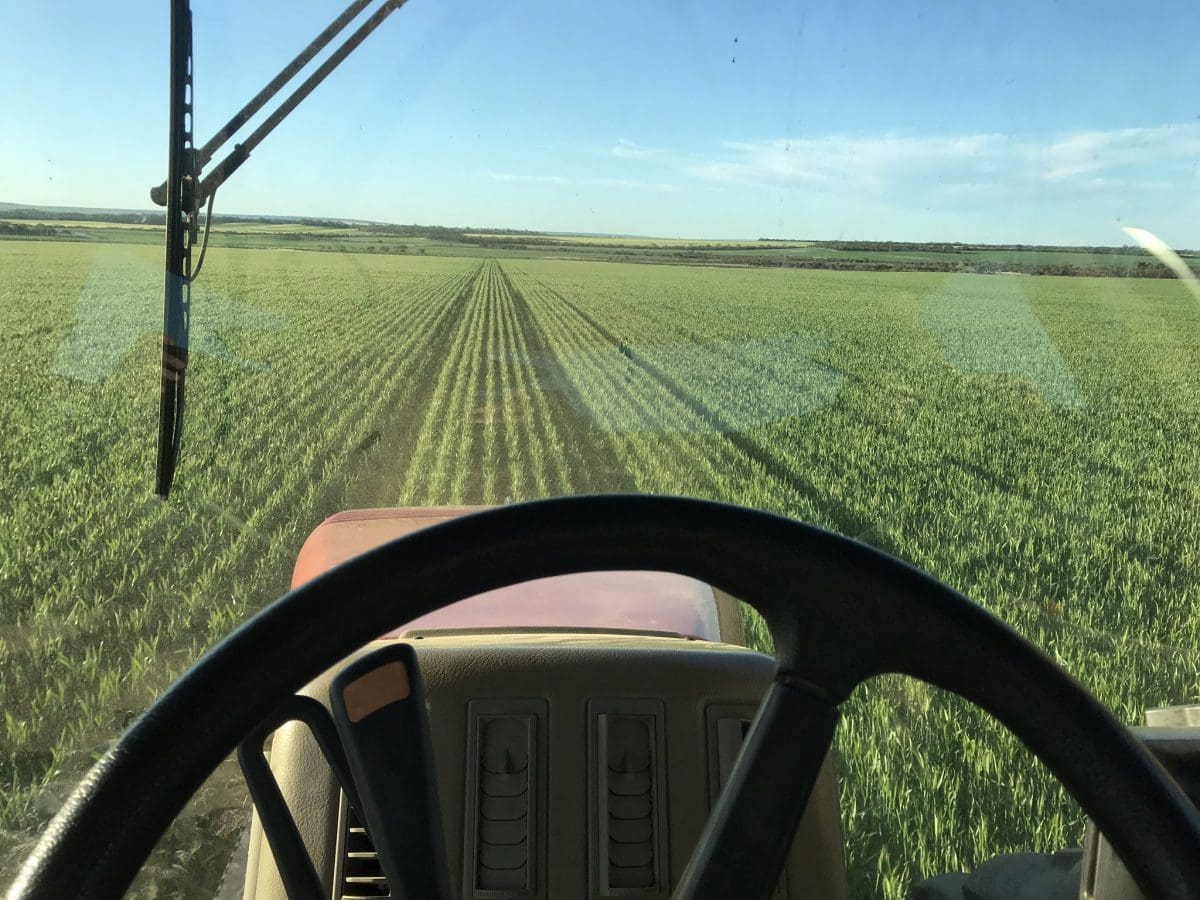
This wheat crop on the Yorke Peninsula is one of many in SA to have received good rain in the past fortnight to bolster yield prospects. Photo: Mark Eden, Arthurton
SOUTH Australia is forecast to produce 8.1 million tonnes (Mt) of grain from the crop currently in the ground, up 8 per cent from 7.5Mt produced last year, according to the Primary Industries and Resources South Australia (PIRSA) 2020-21 Seeding and Crop Establishment report.
Released internally early last month, the report says total crop area sown at 4M hectares (Mha) for all winter crops is well above the five-year average to 2019-20 of 3.75Mha, with seeding completed earlier than usual or close to normal across the state.
Area sown to barley has been reduced by 5 to 10pc in many districts, although the news of China’s barley tariff and resulting reduction in barley prices came too late to enable many farmers to make significant changes to their seeding programs.
Most of the reduced barley area was sown to wheat, canola or pulses.
Good general rain this month has helped to counteract a drier-than-ideal July in most parts of SA excluding the Lower Eyre and Yorke peninsulas, and the South East.
Russian wheat aphids have appeared in the Mid and Lower North, and appear to have been controlled with herbicide to kill self-sown host plants, and also insecticide.
Showery conditions in some districts have called for careful management of weeds and disease risks, and both appear to be largely under control.
Mice, red-legged earth mites, snail and slugs have been among the pests which have created problems for growers in some districts, and these also appear to be under control.
| TONNES | 5yr average to 2019-20 | 2019-20 | 2020-21 |
| Wheat | 4,261,200 | 3,251,500 | 4,557,800 |
| Durum | 118,700 | 82,560 | 92,360 |
| Barley | 2,042,100 | 2,091,000 | 2,235,500 |
| Oats | 150,600 | 120,450 | 142,300 |
| Field peas | 103,400 | 70,100 | 94,600 |
| Faba beans | 116,400 | 156,650 | 168,150 |
| Lentils | 245,200 | 220,400 | 294,720 |
| Canola | 310,800 | 347,400 | 345,350 |
Table 1: SA winter crops with 2020-21 production forecast to exceed 90,000t. Source: PIRSA
| HECTARES | 5yr average to 2019-20 | 2019-20 | 2020-21 |
| Wheat | 2,114,900 | 2,112,100 | 2,228,100 |
| Durum | 49,100 | 42,900 | 39,600 |
| Barley | 832,400 | 990,000 | 926,700 |
| Oats | 78,100 | 72,800 | 75,100 |
| Field peas | 84,200 | 65,300 | 71,500 |
| Faba beans | 74,600 | 98,400 | 102,300 |
| Lentils | 158,400 | 164,300 | 186,100 |
| Canola | 204,100 | 206,600 | 219,300 |
Table 2: Area for SA winter crops with 2020-21 production forecast to exceed 90,000t. Source: PIRSA
Summary by region
Western Eyre Peninsula
May rainfall was average to below average, and June rainfall was very much below average in the Far West and below average in the rest of the district.
Most farmers finished seeding before the end of May, with no significant changes in crop areas.
Strong winds caused drift on exposed sandy rises throughout the region, particularly on paddocks that were recently sown. Persistent windy weather into late June saw many of these areas continue to drift.
Crop growth stage varied greatly depending on sowing date. Early sown crops germinated well and had good yield potential by the end of June.
Cold and dry conditions slowed the emergence and growth of crops sown later, and some had still not emerged more than six weeks after sowing.
Lower Eyre Peninsula
May rainfall was below average in the north-east and average in the remainder of the district. Rainfall for June was average in the north-west and below average in the remainder of the district.
Good opening rains around 25 April enabled most farmers to begin seeding and continued good conditions allowed most to finish before the start of June.
All farmers sowed their planned crop types and areas, indicating that crop area will not vary significantly from the long-term average.
Warm soil temperatures in early May stimulated a rapid germination of early sown crops.
Eastern Eyre Peninsula
May rainfall was average in the east and below average in the remainder of the district. Rainfall for June was very much below average in the east and below average in the rest of the district.
Most farmers finished seeding before the end of May, with most sowing all of their planned crop types and area.
The exception to this was near Wharminda and Rudall which missed early rain, and some farmers did not sow non-wetting sands.
Continued dry conditions affected crop establishment and some crops still had not germinated four to five weeks after sowing.
The area sown to canola and barley was reduced given poor market signals and has mainly been replaced with wheat.
Dry-sown crops in areas that received early rains established quickly and generally have good yield potential. Growth of later-sown crops was slowed by cold conditions in June.
Upper North
Rainfall for May was below average around Carrieton and Quorn and average to above average in the rest of the district.
June rainfall was average in the south-east of the district and below average in the remainder of the district.
Seeding was completed one to two weeks earlier than normal with only a few short weather delays, mainly on heavier soils.
Early sown crops emerged and grew rapidly but later sown crops were slow to emerge as temperatures dropped.
Crop growth was very slow during June due to cold conditions and numerous frosts.
Area sown to barley has been reduced with an increase in mainly wheat and pulses.
Mid North
Rainfall for May and June was generally below average with small areas of average rainfall.
Most farmers completed seeding in the third week May with a few crops sown in late May.
Crop establishment was very even across the district, and cereals as of early July varied in growth stage from three leaf to fully tillered, depending on time of sowing.
Early sown canola had complete ground cover, and later-sown crops were close to full ground cover.
An estimated 5pc reduction in area sown to barley late in the seeding program has taken place, with this area replaced by wheat or pulses, and area sown to hay has increased slightly.
Lower North
May rainfall was below average in the north-west and average in the remainder of the district. Rainfall for June was average in the south-east and below average in the rest of the district.
Seeding was completed seven to 10 days earlier than normal with minimal delays.
Stored soil moisture levels are moderate with moisture to a depth of 40cm in the higher rainfall parts of the district.
The area sown to barley was reduced by 5 to 10% and replaced by either wheat or canola.
Crops emerged well but growth has been slow due to the below average temperatures in June.
Yorke Peninsula
Rainfall for May varied from below average in Central Yorke Peninsula to above average in parts of Southern Yorke Peninsula. June rainfall was average on Southern Yorke Peninsula and below average on Central and Northern Yorke Peninsula.
Seeding was completed the end of May, an earlier finish than usual in Southern Yorke Peninsula.
Stored soil moisture levels range from 20-50pc of capacity with higher amounts mainly on lighter, sandier soils.
Wheat area remained stable but there was a 5pc reduction in the area sown to barley. This has been replaced by mainly lentils, which are up 5-10pc in area, and canola.
Early sown crops on Northern Yorke Peninsula were at late tillering stage in early July, while canola crops sown in mid-April were budding, wheat ranged from three-leaf to mid-tillering stage, and lentil and chickpea crops started to branch.
Murray Mallee
In the northern Murray-Mallee, May rainfall was average in the south and below average in the north, while June rainfall was below average in the north-west and average in the remainder of the district.
In the southern Murray-Mallee, May rainfall was average, and June rainfall was below average in the west and average in the remainder of the district.
Northern Murray-Mallee crops were generally sown on time after excellent opening rains and most farmers finished seeding by the end of May.
Farmers in the district’s north generally increased the area sown to wheat, chickpeas, canola and vetch this season, and reduced intended barley area due to forecast lower prices.
South East
May rainfall was average to above average, and June rainfall was above average to below average across the district.
Crops were generally sown at the optimum time in the Upper South East, with most farmers finishing seeding one to three weeks earlier than normal.
The Upper South East has seen a 15pc drop in barley area in response to Chinese tariffs, with wheat, milling oats and canola taking its place.
In the Lower South East, seeding was completed around the normal time despite many producers commencing seeding earlier than usual, and most crops emerged well, despite conditions slowing growth.
Grain Central: Get our free daily cropping news straight to your inbox – Click here

HAVE YOUR SAY